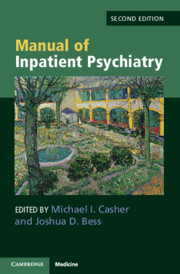Book contents
- Manual of Inpatient Psychiatry
- Manual of Inpatient Psychiatry
- Copyright page
- Contents
- Contributors
- Preface to the Second Edition
- Foreword: American Inpatient Psychiatry in Historical Perspective
- Chapter 1 The Inpatient with Schizophrenia
- Chapter 2 The Inpatient with Depression
- Chapter 3 The Inpatient with Mania
- Chapter 4 The Inpatient with Borderline Personality Disorder
- Chapter 5 The Inpatient with Dementia
- Chapter 6 The Inpatient with Traumatic Brain Injury
- Chapter 7 The Inpatient with Dual Diagnosis (Co-Occurring Disorder)
- Chapter 8 The Young Adult on the Inpatient Unit
- Chapter 9 Clinical Documentation on the Inpatient Unit
- Index
- References
Chapter 6 - The Inpatient with Traumatic Brain Injury
Published online by Cambridge University Press: 05 March 2020
- Manual of Inpatient Psychiatry
- Manual of Inpatient Psychiatry
- Copyright page
- Contents
- Contributors
- Preface to the Second Edition
- Foreword: American Inpatient Psychiatry in Historical Perspective
- Chapter 1 The Inpatient with Schizophrenia
- Chapter 2 The Inpatient with Depression
- Chapter 3 The Inpatient with Mania
- Chapter 4 The Inpatient with Borderline Personality Disorder
- Chapter 5 The Inpatient with Dementia
- Chapter 6 The Inpatient with Traumatic Brain Injury
- Chapter 7 The Inpatient with Dual Diagnosis (Co-Occurring Disorder)
- Chapter 8 The Young Adult on the Inpatient Unit
- Chapter 9 Clinical Documentation on the Inpatient Unit
- Index
- References
Summary
In recent years inpatient psychiatrists have become increasingly adept at recognizing and treating patients with neuropsychiatric sequelae of traumatic brain injury (TBI) [1–8]. In addition to the commonly seen TBI-related cognitive impairment, which is not the focus of this chapter, many post-TBI patients display atypical forms of mood and anxiety disorders, or present with personality alterations and/or signs of behavioral dysregulation. Less frequently, long-term effects of TBI include various forms of psychosis, including delusions with persecutory content, and visual or auditory hallucinations. Expertise in recognition and management of TBI is made even more crucial by the increasing incidence of brain injuries in society, with US emergency departments treating 444 new TBI cases per year per 100 000 people, and with worldwide average estimate of 295 new cases per 100 000 persons. Peak incidence for TBI in the USA occurs between the ages of 15 and 24 years old.
- Type
- Chapter
- Information
- Manual of Inpatient Psychiatry , pp. 126 - 141Publisher: Cambridge University PressPrint publication year: 2020



